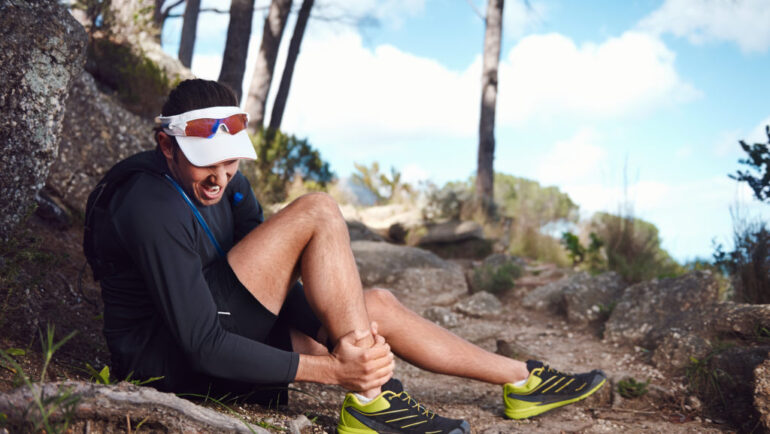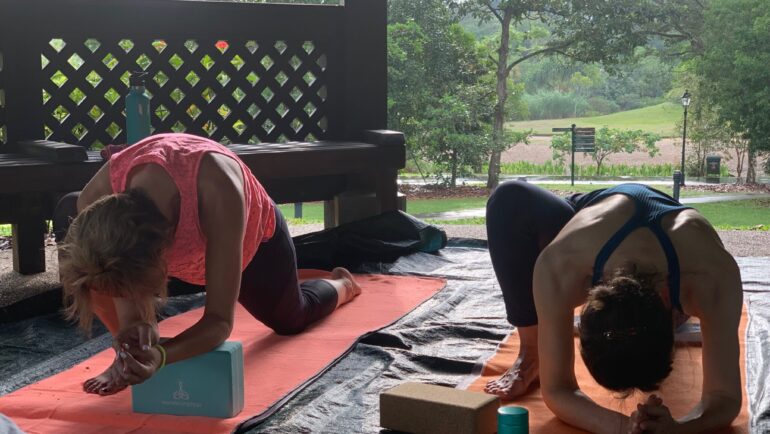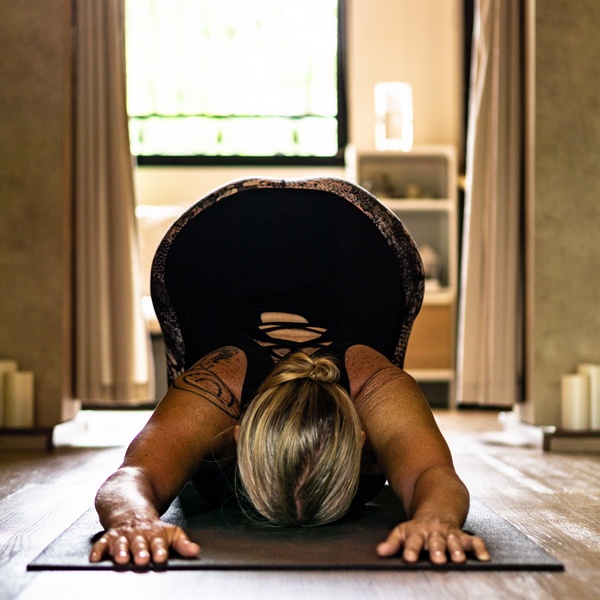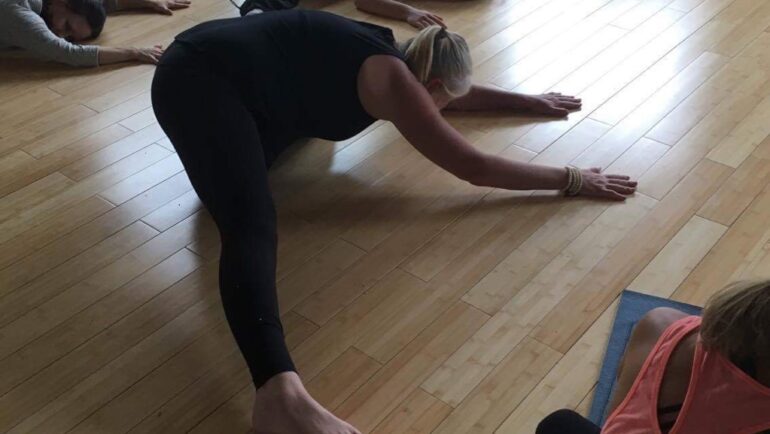Ever had an injury you can’t quite work through? Having a hard time pinning it down? It’s probably your fascia talking. WanderingyogiLee explores the fashion for all things fascia, and finds there is a reason for the buzz.
All of us know about muscles, joints, ligaments – how we can stretch muscles (dynamically/passively), how to build strength. To a lesser extent, we know how important it is for joints to be stressed through compression, and ligaments with a consistent heavy loading. Many of us now know about fascia. That stuff that binds us in varying degrees of elasticity from top to bottom, inside out.
A brief description of Fascia
Our muscles are encased in fascia, a continuous web of tissue that weaves in and around not only our muscles but also our organs, nerves and lymph.
Like a silk body stocking, on the inside of our bodies. The whiteish, sometimes glistening fibres you see when you pull a piece of meat apart – that is fascia. It stabilizes, encloses and separates muscles, attaches muscles and organs and bones to each other. It is the stuff that holds us together.
Imagine all our muscles, bones and organs, being held in this human form, with the skeleton as its foundation. It is truly a case of the hip bones are connected to the shoulder bones, the shoulder bones are connected to the ankle bones…
Whenever we move our body, our fascia has to respond to keep our body in balance, and western science believes it is far more ‘intelligent’ than muscles.
When we trip or fall, we may pull a muscle. But often that ongoing pain is most likely the fascia complaining about taking the brunt of the injury.

Fascia fun facts
When fascia is healthy (read relatively supple), it allows our body to move as freely as it can, yet holds us together. It connects the upper part of our body with the lower part, for example. When it is unhealthy or restricted, it binds the muscles making movement and exercise limited, with pressure as great as 2,000 pounds per square inch.
This explains why sometimes we have an injury that just won’t go away, with a pain level far in excess of what may have caused the initial injury, and also appearing to be larger than the initial injury point. (If you have ever had an Achilles tendon injury, you will know exactly what I mean).
On average our body is 60% water (the brain 73%, the lungs 83%). Muscles about 80%. Fascia is somewhere between 12% – 20% water. That achilles tendon is about 12% water, which is why it rips or tears, you never pull one of these.
This biomolecular make up of fascia makes it super strong. If it was on the outside of our body, we would probably be bulletproof. WYOGILEE
Mainstream anatomy atlases and kinesiology texts tend to reduce us to Newtonian biomechanics of forces and levers as if we are manufactured from parts like a car or a computer. This explains some behaviors of our body but obscures others.
For example, we are one massive electromagnetic field (our heart transmits enough energy for another to person to ‘feel’ whether we like them or not), yet western science still cannot describe what is going on in the days we feel absolutely fantastic and others not so.
Fascia challenges us to conventional notions of mobility, with the idea that you work from the inside out, not the other way round if you want a truly healthy body.
Fascia Health – let’s get physical
With the discovery of fascia as something other than a weird covering over our muscles, a large array of alternative physical therapy from ‘mainstream’ to the slightly off beat. MFR (Myofascial Release), Rolling, you probably know a few more.
I’ve done my research of journals, articles written by scientists within mainstream and alternative therapies, and coupled it with my own 25 something years of experience as a yoga teacher and lover of yin.
Many of these alternatives lack reasonable evidence for the claimed benefits of helping fascia (by reasonable I mean, some study of some sort to some standard of analysis). Particularly those that suggest massage or rolling of muscles will repair or release fascia. They might help something else though.
For example, massage releases ligaments and tendons, which are technically fascia, but that white gooey stuff, that amazing web that holds us from top to bottom, no way. I love a good massage, and I have a special asana using the block for the neck, which involves rolling, and the groans of pleasure/pain I hear when students use it, strongly suggest there is some immediate benefit for those tight muscles.
As for repairing and releasing fascia, I doubt it.
By far the greatest love you can give your fascia is to STOP MOVING WanderingyogiLee

This idea of staying still in a pose for an extended period of time is at the heart of yin practice. I can assure you staying still does not mean nothing is happening. From a biomechanics perspective, you need to hold low loads on the tight areas for long periods of time to enable the deeper fascia to ‘stretch’ and be nourished.
If you challenged anyone who has stayed still in Dragon pose for any length of time that nothing was going on, they might give you the stink eye. Because they will tell you they might have felt nauseous, perhaps a bit angry.
It’s just that nothing in particular and knowable is going on that western science can easily explain.
Fascia Health – I feel you
I have taught yin now for nearly 20 years. As its teacher, it took a while for me to pick up the energetic nuances of yin in my students. There were obvious ones – people silently sobbing, the calmness that follows anahatasana (melting heart pose).
But for the most part, it is what you or I cannot see that is going on in Yin.

When I began my study in Wu-Xing and TCM (Traditional Chinese Medicine), the idea of fascia being conduits that enable energy flow in the body was a lightbulb moment. The second lightbulb moment was learning these energy conduits also hold emotions.
There is a saying that the body knows the score. We communicate with our body from the moment we are borne, we then learn to speak and often forget that the body was our first expression of feeling. How often have you had sore shoulders, feel like you have the world on your shoulders? When you have a broken heart, do you feel that aching in the tips of your fingers or toes? When you have been betrayed, the desire to throw up? When you laugh, the fire that rises into your face?
The Wu-Xing and TCM says we have energy lines (meridians) which feed our major organs, and contain our feelings. The meridians run through our body, in a pattern, rather like rivers and their tributaries.
By applying pressure to certain points or areas along these meridians, emotional energy is released or held back, and our body experiences change literally from the inside out.
Yin yoga allows us to gently move energy, remove congestion, and release. In my yin yoga, I also teach microcompressions, like a mini acupressure session in the yoga practice.
Tips for a fantastic Fascia
Our fascia is plastic (but not elastic), meaning we can change it, with the changes being more permanent than muscle strength or stretch. Here are some suggestions for making the most of fascia.
1. Practice Yin
Fascia is strong and stubborn – you have to move slow and hold gentle stretches for long periods of times (at least 3 times longer than any other form of physical activity, including more traditional yoga). If you have significant body tightness, see a good physiotherapist or other bodyworker who understands fascia. Good news though – a regular practice of yin will result in your fascia taking a new shape, holding its place much longer than muscles do.

2. Acupuncture
Reduces local inflammation and enhances blood circulation to reduce the pain. It also rebalances and shakes up the energy lines within our body.
3. Drink loads of water
When you consider just how little water is in our fascia, drinking more just makes sense. Particularly after a yin practice.
This web of silken tensegrity we call fascia can help us move more freely, stand more steadily, and live a longer healthy life. All we have to do is look after it.

Lee Carsley is the Wanderingyogi. A teacher of yoga and meditation for many years, she also uses her energy gifts to help others become the most aum-some they can be – which is pretty aum-some.





